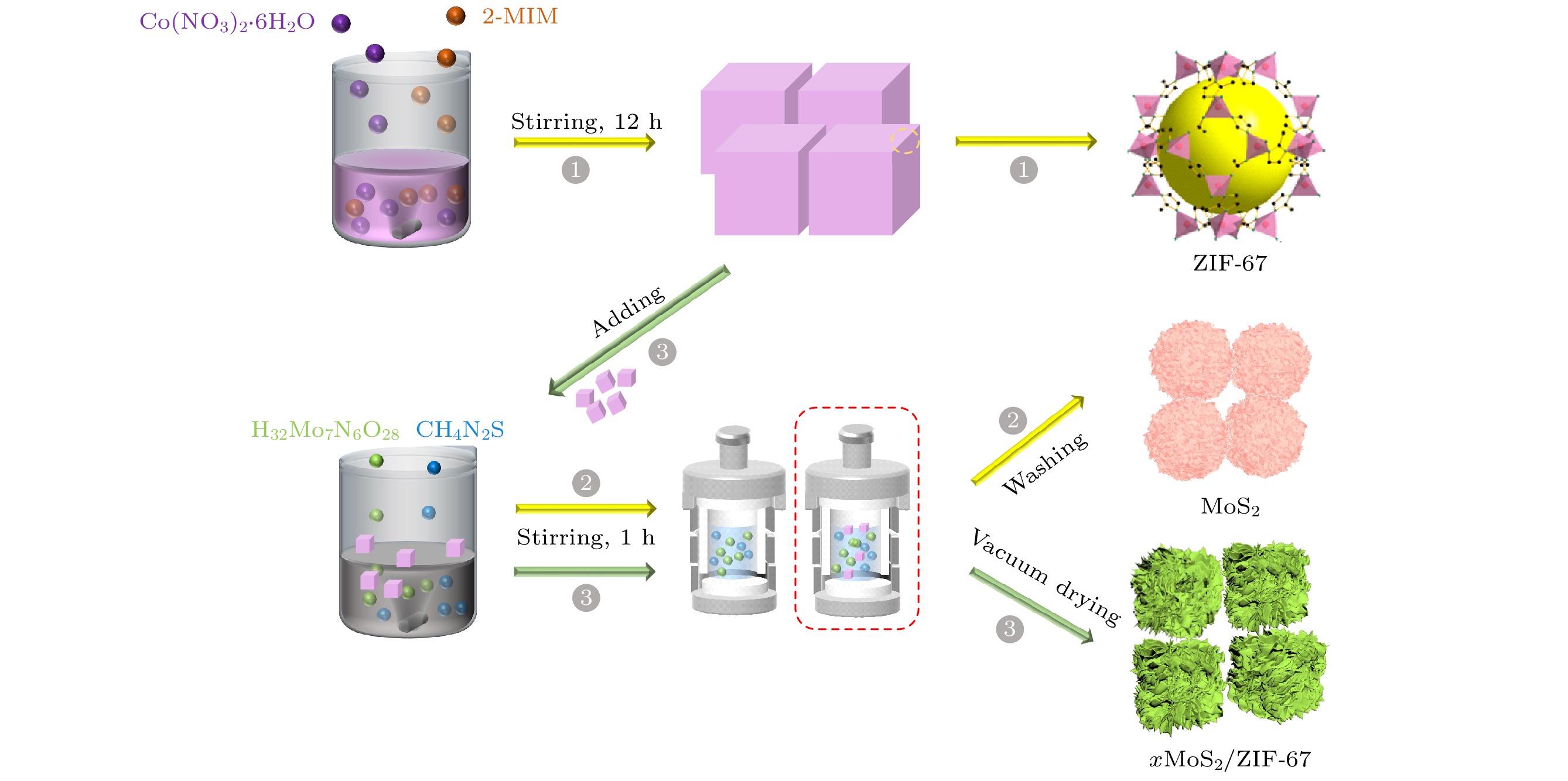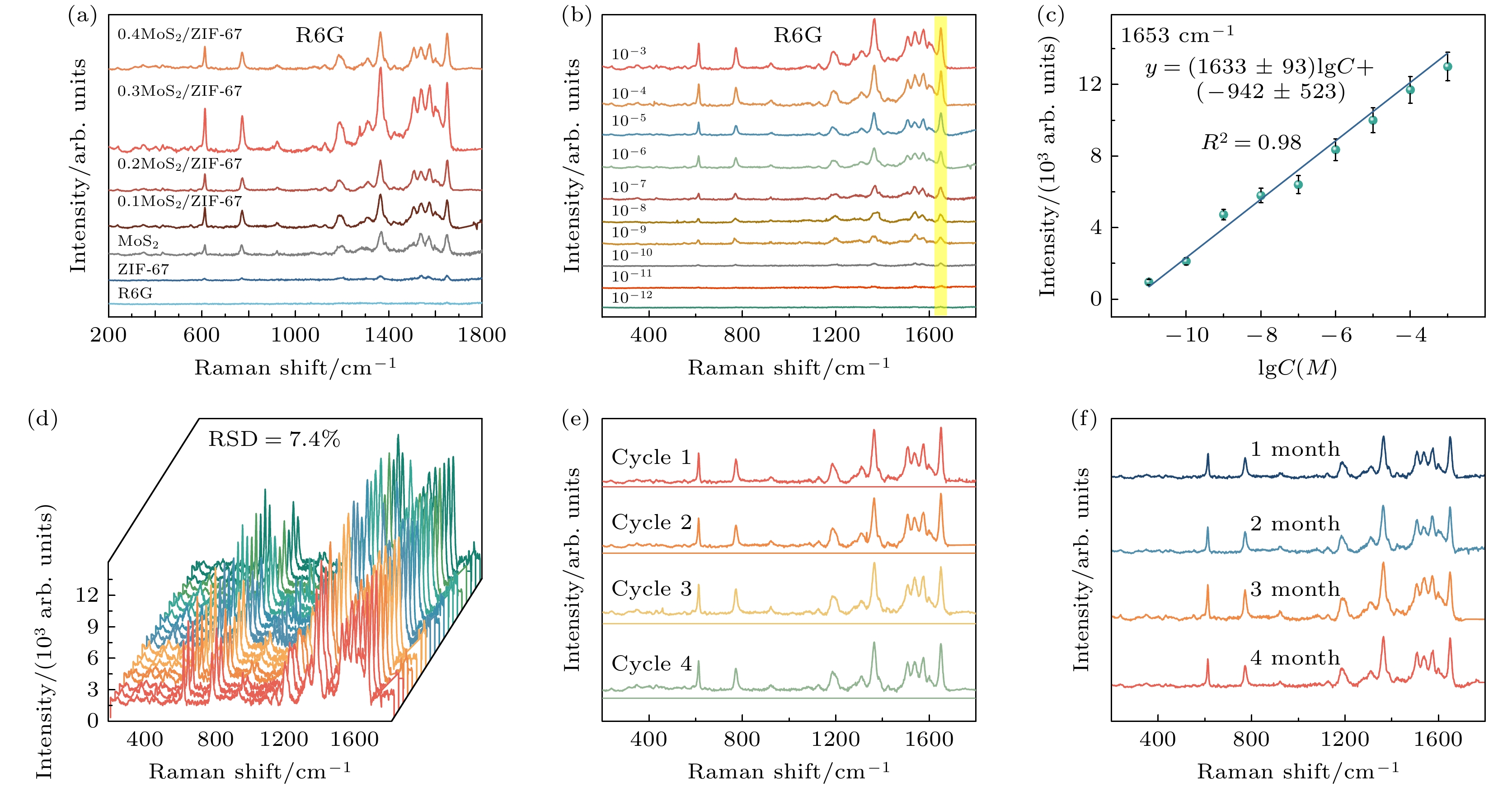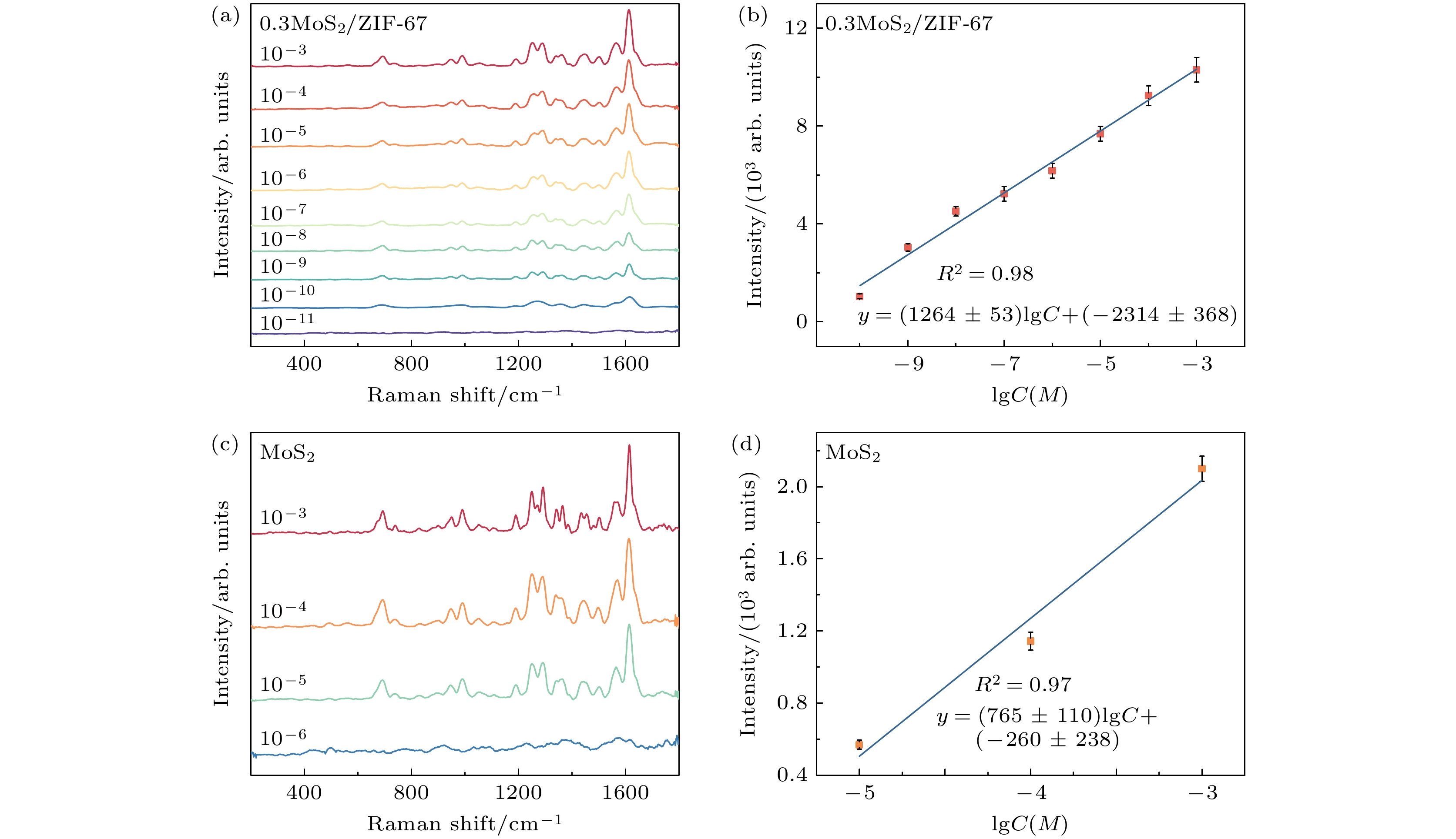-
地球上丰富的二硫化钼(MoS2)作为一种有前景的表面增强拉曼光谱(SERS)基底引起了人们的广泛关注, 但由于其半导体特性而限制了其发展. 因此, 本文设计了一种MoS2/沸石咪唑酯骨架-67(ZIF-67)异质结构作为SERS基底, 该基底具有优异的灵敏度, 增强因子可达6.68×106. 此外, 利用MoS2/ZIF-67对胆红素进行无标记检测, 检测限低至10–10 mol/L. 同时, 该基底暴露在空气中4个月后, SERS性能基本保持不变, 表明该基底具有较高的稳定性和可重复使用性. 该基底优秀的性能主要是由于MoS2的垂直分布结构能暴露出更多的活性位点. 同时, ZIF-67具有较大的比表面积和丰富的孔洞结构, 这也为分子提供了大量的吸附位点. 此外, 内部电荷转移诱导了高比例稳定1T相的形成, 从而提高了电导率. 本文为合理设计用于高灵敏SERS检测的无贵金属材料提供了有价值的参考.Earth-abundant molybdenum disulfide (MoS2), as a promising substrate for surface-enhanced Raman spectroscopy (SERS), has attracted considerable attention. Naturally occurring MoS2 primarily exists in the semiconducting 2H phase, but its SERS performance is limited because active sites are typically confined to its edges. Furthermore, the irregular agglomeration of MoS2 can lead to performance degradation, making natural semiconducting material unsuitable for practical applications. Therefore, enhancing the performance of MoS2 in the field of SERS is of great significance. Metal-organic frameworks (MOFs) are ideal materials for building efficient SERS substrates due to their tunable pore structures. Among various MOF materials, zeolitic imidazolate frameworks (ZIFs) have aroused significant interest due to their well-defined polyhedral structures, homogeneity, and small particle sizes. Therefore, in this study, MoS2/zeolitic imidazolate framework-67 (ZIF-67) heterostructures are prepared by the hydrothermal method as SERS substrates, which exhibits exceptionaly high sensitivity to rhodamine 6G with an enhancement factor of up to 6.68×106. Moreover, after SERS is exposed to air for four months, its performance remains almost unchanged, demonstrating high stability and reusability. To evaluate the actual detection ability of this substrate, bilirubin is selected as the analyte, which is a clinically relevant metabolic waste. Since both high and low concentrations of free bilirubin can lead to cardiovascular and cerebrovascular diseases, accurate monitoring of bilirubin levels is crucial for diagnosing bilirubin-induced disorders. Using the MoS2/ZIF-67 substrate, the label-free detection of bilirubin is achieved with a limit of detection as low as 10–10 mol/L. The outstanding performance of this substrate can be attributed to the vertically aligned MoS2 nanostructure, which exposes more active sites. Additionally, ZIF-67 provides a high specific surface area and abundant porous structures, providing numerous adsorption sites for target molecules. Furthermore, the internal charge transfer facilitates the formation of a highly conductive 1T phase, thereby improving electrical conductivity. This work provides valuable insights into the rational designing of noble-metal-free materials for highly sensitive SERS detection.
-
Keywords:
- surface-enhanced Raman spectroscopy /
- MoS2 /
- ZIF-67 /
- heterostructure
[1] Odum E P 1969 Science 164 262
 Google Scholar
Google Scholar
[2] Guo Y, Liu Y 2022 J. Geog. Sci. 32 23
 Google Scholar
Google Scholar
[3] Zhang Y, Gao F, Wang D, Li Z, Wang X, Wang C, Zhang K, Du Y 2023 Coord. Chem. Rev. 475 214916
 Google Scholar
Google Scholar
[4] Li Y, Zhang J, Chen Q, Xia X, Chen M 2021 Adv. Mater. 33 2100855
 Google Scholar
Google Scholar
[5] Hou H, Anichini C, Samorì P, Criado A, Prato M 2022 Adv. Funct. Mater. 32 2207065
 Google Scholar
Google Scholar
[6] Li J, Chen C, Lv Z, Ma W, Wang M, Li Q, Dang J 2023 J. Mater. Sci. Technol. 145 74
 Google Scholar
Google Scholar
[7] Gong C, Li W, Lei Y, He X, Chen H, Du X, Fang W, Wang D, Zhao L 2022 Composites Part B 236 109823
 Google Scholar
Google Scholar
[8] Reyren N, Thiel S, Caviglia A D, Kourkoutis L F, Hammerl G, Richter C, Schneider C W, Kopp T, Rüetschi A S, Jaccard D, Gabay M, Muller D A, Triscone J-M, Mannhart J 2007 Science 317 1196
 Google Scholar
Google Scholar
[9] Ohtomo A, Hwang H Y 2004 Nature 427 423
 Google Scholar
Google Scholar
[10] Chen W, Zhu X, Wang R, Wei W, Liu M, Dong S, Ostrikov K K, Zang S Q 2022 J. Energy Chem. 75 16
 Google Scholar
Google Scholar
[11] Xia T, Zhou L, Gu S, Gao H, Ren X, Li S, Wang R, Guo H 2021 Mater. Des. 211 110165
 Google Scholar
Google Scholar
[12] Wang H, Niu Z, Peng Z, Wu X, Gao C, Zhao S, Kim Y D, Wu H, Du X, Liu Z, Li B 2022 ACS Appl. Mater. Interfaces 14 9116
 Google Scholar
Google Scholar
[13] Xu H, Zhu J, Ma Q, Ma J, Bai H, Chen L, Mu S 2021 Micromachines 12 240
 Google Scholar
Google Scholar
[14] Cao Y 2021 ACS Nano 15 11014
 Google Scholar
Google Scholar
[15] He H, Li X, Huang D, Luan J, Liu S, Pang W K, Sun D, Tang Y, Zhou W, He L, Zhang C, Wang H, Guo Z 2021 ACS Nano 15 8896
 Google Scholar
Google Scholar
[16] Peng H, Zhou K, Jin Y, Zhang Q, Liu J, Wang H 2022 Chem. Eng. J. 429 132477
 Google Scholar
Google Scholar
[17] Wang H, Fu W, Yang X, Huang Z, Li J, Zhang H, Wang Y 2020 J. Mater. Chem. A 8 6926
 Google Scholar
Google Scholar
[18] Huang Z, Yuan S, Zhang T, Cai B, Xu B, Lu X, Fan L, Dai F, Sun D 2020 Appl. Catal. , B 272 118976
 Google Scholar
Google Scholar
[19] Zhang X, Zhang S, Tang Y, Huang X, Pang H 2022 Composites Part B 230 109532
 Google Scholar
Google Scholar
[20] Yang J, Zhang C, Niu Y, Huang J, Qian X, Wong K Y 2021 Chem. Eng. J. 409 128293
 Google Scholar
Google Scholar
[21] Wu Y, Wang Z, Liang M, Cheng H, Li M, Liu L, Wang B, Wu J, Prasad Ghimire R, Wang X, Sun Z, Xue S, Qiao Q 2018 ACS Appl. Mater. Interfaces 10 17883
 Google Scholar
Google Scholar
[22] Zhou L, Zhuang Z, Zhao H, Lin M, Zhao D, Mai L 2017 Adv. Mater. 29 1602914
 Google Scholar
Google Scholar
[23] Quan Y, Li J, Hu M, Wei M, Yang J, Gao M, Liu Y 2022 Appl. Surf. Sci. 598 153750
 Google Scholar
Google Scholar
[24] Li M, Cai B, Tian R, Yu X, Breese M B H, Chu X, Han Z, Li S, Joshi R, Vinu A, Wan T, Ao Z, Yi J, Chu D 2021 Chem. Eng. J. 409 128158
 Google Scholar
Google Scholar
[25] Xu J, Cheng C, Shang S, Gao W, Zeng P, Jiang S 2020 ACS Appl. Mater. Interfaces 12 49452
 Google Scholar
Google Scholar
[26] Li Q, Huang F, Li S, Zhang H, Yu X 2022 Small 18 2104323
 Google Scholar
Google Scholar
[27] Sundara Venkatesh P, Kannan N, Ganesh Babu M, Paulraj G, Jeganathan K 2022 Int. J. Hydrogen Energy 47 37256
 Google Scholar
Google Scholar
[28] Xu J, Shang S, Gao W, Zeng P, Jiang S 2021 Cellulose 28 7389
 Google Scholar
Google Scholar
[29] Chen Y, Meng G, Yang T, Chen C, Chang Z, Kong F, Tian H, Cui X, Hou X, Shi J 2022 Chem. Eng. J. 450 138157
 Google Scholar
Google Scholar
[30] Rafiei S, Tangestaninejad S, Horcajada P, Moghadam M, Mirkhani V, Mohammadpoor-Baltork I, Kardanpour R, Zadehahmadi F 2018 Chem. Eng. J. 334 1233
 Google Scholar
Google Scholar
[31] Chang J, Wang Y, Chen L, Wu D, Xu F, Bai Z, Jiang K, Gao Z 2020 Int. J. Hydrogen Energy 45 12787
 Google Scholar
Google Scholar
[32] Hou B, Wu J 2020 Dalton Trans. 49 17621
 Google Scholar
Google Scholar
[33] Leng X, Wang Y, Wang F 2019 Adv. Mater. Interfaces 6 1900010
 Google Scholar
Google Scholar
[34] Mohammadpour E, Asadpour-Zeynali K 2020 Microchem J. 157 104939
 Google Scholar
Google Scholar
[35] Hou X, Zhou H, Zhao M, Cai Y, Wei Q 2020 ACS Sustainable Chem. Eng. 8 5724
 Google Scholar
Google Scholar
[36] Liu Z, Gao Z, Liu Y, Xia M, Wang R, Li N 2017 ACS Appl. Mater. Interfaces 9 25291
 Google Scholar
Google Scholar
[37] Li X, Lü X, Li N, Wu J, Zheng Y Z, Tao X 2019 Appl. Catal., B 243 76
 Google Scholar
Google Scholar
[38] Mu X, Zhu Y, Gu X, Dai S, Mao Q, Bao L, Li W, Liu S, Bao J, Mu S 2021 J. Energy Chem. 62 546
 Google Scholar
Google Scholar
[39] Lei Z, Zhan J, Tang L, Zhang Y, Wang Y 2018 Adv. Energy Mater. 8 1703482
 Google Scholar
Google Scholar
[40] Gao B, Zhao Y, Du X, Li D, Ding S, Li Y, Xiao C, Song Z 2021 Chem. Eng. J. 411 128567
 Google Scholar
Google Scholar
[41] Kochat V, Apte A, Hachtel J A, Kumazoe H, Krishnamoorthy A, Susarla S, Idrobo J C, Shimojo F, Vashishta P, Kalia R, Nakano A, Tiwary C S, Ajayan P M 2017 Adv. Mater. 29 1703754
 Google Scholar
Google Scholar
[42] Sim D M, Han H J, Yim S, Choi M J, Jeon J, Jung Y S 2017 ACS Omega 2 4678
 Google Scholar
Google Scholar
[43] Nguyen D C, Tran D T, Doan T L L, Kim D H, Kim N H, Lee J H 2020 Adv. Energy Mater. 10 1903289
 Google Scholar
Google Scholar
[44] Zhu H, Zhang J, Yanzhang R, Du M, Wang Q, Gao G, Wu J, Wu G, Zhang M, Liu B, Yao J, Zhang X 2015 Adv. Mater. 27 4752
 Google Scholar
Google Scholar
[45] Solomon G, Landström A, Mazzaro R, Jugovac M, Moras P, Cattaruzza E, Morandi V, Concina I, Vomiero A 2021 Adv. Energy Mater. 11 2101324
 Google Scholar
Google Scholar
[46] Ganesan P, Sivanantham A, Shanmugam S 2018 J. Mater. Chem. A 6 1075
 Google Scholar
Google Scholar
[47] Li W, Liu J, Guo P, Li H, Fei B, Guo Y, Pan H, Sun D, Fang F, Wu R 2021 Adv. Energy Mater. 11 2102134
 Google Scholar
Google Scholar
[48] Sun H, Yao M, Song Y, Zhu L, Dong J, Liu R, Li P, Zhao B, Liu B 2019 Nanoscale 11 21493
 Google Scholar
Google Scholar
[49] Wang X, Han Y, Liu Y, Yu Y, Ma J, Yang T, Hu J, Huang H 2023 Int. J. Hydrogen Energy 48 3048
 Google Scholar
Google Scholar
[50] Wang Y, Zeng C, Zhang Y, Su R, Yang D, Wang Z, Wu Y, Pan H, Zhu W, Hu W, Liu H, Yang R 2022 Mater. Today Phys. 22 100600
 Google Scholar
Google Scholar
[51] Sun S, Zheng J, Sun R, Wang D, Sun G, Zhang X, Gong H, Li Y, Gao M, Li D, Xu G, Liang X 2022 Nanomaterials 12 896
 Google Scholar
Google Scholar
[52] Gupta J D, Jangra P, Mishra A K 2025 ACS Appl. Nano Mater. 8 7449
 Google Scholar
Google Scholar
[53] Lombardi J R, Birke R L 2014 J. Phys. Chem. C 118 11120
 Google Scholar
Google Scholar
-
图 3 基底的SEM, TEM和EDS图 (a) MoS2, (b) ZIF-67和(c) 0.3MoS2/ZIF-67的SEM图像; (d) MoS2, (e) ZIF-67和(f) 0.3MoS2/ZIF-67的TEM图像; (g) 0.3MoS2/ZIF-67的HRTEM; (h) 图(g)中蓝色矩形区域放大后的图片; (i)—(l) Co, Mo, S, O的EDS元素映射图
Fig. 3. SEM images of (a) MoS2, (b) ZIF-67 and (c) 0.3MoS2/ZIF-67; TEM images of (d) MoS2, (e) ZIF-67 and (f) 0.3MoS2/ZIF-67; (g) HRTEM of 0.3MoS2/ZIF-67; (h) magnified domains of the blue rectangle; (i)–(l) EDS element mapping images of Co, Mo, S and O.
图 5 基底的拉曼光谱和SERS性能图 (a) R6G(10–3 mol/L)吸附在MoS2, ZIF-67和xMoS2/ZIF-67上的SERS谱图; (b) 0.3MoS2/ZIF-67基底上不同浓度R6G的SERS光谱; (c) 1653 cm–1处SERS强度与对数浓度的线性关系; (d) 0.3MoS2/ZIF-67的可重复性、(e)循环性和(f)稳定性表征
Fig. 5. (a) SERS spectra of R6G (10–3 mol/L) adsorbed on MoS2, ZIF-67 and xMoS2/ZIF-67; (b) SERS spectra of R6G of various concentrations enhanced by 0.3MoS2/ZIF-67; (c) linear relationship of SERS intensities at 1653 cm–1 versus logarithm of concentration; (d) reproducibility, (e) cyclicity and (f) stability of 0.3MoS2/ZIF-67.
图 7 复合后的基底与非复合基底的SERS性能对比图 (a)不同浓度胆红素在0.3MoS2/ZIF-67基底上的SERS光谱和(b) 1614 cm–1处信号强度与胆红素对数浓度的关系; (c)不同浓度胆红素在MoS2基底上的SERS光谱和(d) 1614 cm–1处信号强度与胆红素对数浓度的关系
Fig. 7. SERS spectra of (a) 0.3MoS2/ZIF-67 and (c) MoS2 substrates with various concentrations of bilirubin. Plot of the intensity at 1614 cm–1 against the logarithmic concentration of bilirubin in the presence of (b) 0.3MoS2/ZIF-67 and (d) MoS2.
-
[1] Odum E P 1969 Science 164 262
 Google Scholar
Google Scholar
[2] Guo Y, Liu Y 2022 J. Geog. Sci. 32 23
 Google Scholar
Google Scholar
[3] Zhang Y, Gao F, Wang D, Li Z, Wang X, Wang C, Zhang K, Du Y 2023 Coord. Chem. Rev. 475 214916
 Google Scholar
Google Scholar
[4] Li Y, Zhang J, Chen Q, Xia X, Chen M 2021 Adv. Mater. 33 2100855
 Google Scholar
Google Scholar
[5] Hou H, Anichini C, Samorì P, Criado A, Prato M 2022 Adv. Funct. Mater. 32 2207065
 Google Scholar
Google Scholar
[6] Li J, Chen C, Lv Z, Ma W, Wang M, Li Q, Dang J 2023 J. Mater. Sci. Technol. 145 74
 Google Scholar
Google Scholar
[7] Gong C, Li W, Lei Y, He X, Chen H, Du X, Fang W, Wang D, Zhao L 2022 Composites Part B 236 109823
 Google Scholar
Google Scholar
[8] Reyren N, Thiel S, Caviglia A D, Kourkoutis L F, Hammerl G, Richter C, Schneider C W, Kopp T, Rüetschi A S, Jaccard D, Gabay M, Muller D A, Triscone J-M, Mannhart J 2007 Science 317 1196
 Google Scholar
Google Scholar
[9] Ohtomo A, Hwang H Y 2004 Nature 427 423
 Google Scholar
Google Scholar
[10] Chen W, Zhu X, Wang R, Wei W, Liu M, Dong S, Ostrikov K K, Zang S Q 2022 J. Energy Chem. 75 16
 Google Scholar
Google Scholar
[11] Xia T, Zhou L, Gu S, Gao H, Ren X, Li S, Wang R, Guo H 2021 Mater. Des. 211 110165
 Google Scholar
Google Scholar
[12] Wang H, Niu Z, Peng Z, Wu X, Gao C, Zhao S, Kim Y D, Wu H, Du X, Liu Z, Li B 2022 ACS Appl. Mater. Interfaces 14 9116
 Google Scholar
Google Scholar
[13] Xu H, Zhu J, Ma Q, Ma J, Bai H, Chen L, Mu S 2021 Micromachines 12 240
 Google Scholar
Google Scholar
[14] Cao Y 2021 ACS Nano 15 11014
 Google Scholar
Google Scholar
[15] He H, Li X, Huang D, Luan J, Liu S, Pang W K, Sun D, Tang Y, Zhou W, He L, Zhang C, Wang H, Guo Z 2021 ACS Nano 15 8896
 Google Scholar
Google Scholar
[16] Peng H, Zhou K, Jin Y, Zhang Q, Liu J, Wang H 2022 Chem. Eng. J. 429 132477
 Google Scholar
Google Scholar
[17] Wang H, Fu W, Yang X, Huang Z, Li J, Zhang H, Wang Y 2020 J. Mater. Chem. A 8 6926
 Google Scholar
Google Scholar
[18] Huang Z, Yuan S, Zhang T, Cai B, Xu B, Lu X, Fan L, Dai F, Sun D 2020 Appl. Catal. , B 272 118976
 Google Scholar
Google Scholar
[19] Zhang X, Zhang S, Tang Y, Huang X, Pang H 2022 Composites Part B 230 109532
 Google Scholar
Google Scholar
[20] Yang J, Zhang C, Niu Y, Huang J, Qian X, Wong K Y 2021 Chem. Eng. J. 409 128293
 Google Scholar
Google Scholar
[21] Wu Y, Wang Z, Liang M, Cheng H, Li M, Liu L, Wang B, Wu J, Prasad Ghimire R, Wang X, Sun Z, Xue S, Qiao Q 2018 ACS Appl. Mater. Interfaces 10 17883
 Google Scholar
Google Scholar
[22] Zhou L, Zhuang Z, Zhao H, Lin M, Zhao D, Mai L 2017 Adv. Mater. 29 1602914
 Google Scholar
Google Scholar
[23] Quan Y, Li J, Hu M, Wei M, Yang J, Gao M, Liu Y 2022 Appl. Surf. Sci. 598 153750
 Google Scholar
Google Scholar
[24] Li M, Cai B, Tian R, Yu X, Breese M B H, Chu X, Han Z, Li S, Joshi R, Vinu A, Wan T, Ao Z, Yi J, Chu D 2021 Chem. Eng. J. 409 128158
 Google Scholar
Google Scholar
[25] Xu J, Cheng C, Shang S, Gao W, Zeng P, Jiang S 2020 ACS Appl. Mater. Interfaces 12 49452
 Google Scholar
Google Scholar
[26] Li Q, Huang F, Li S, Zhang H, Yu X 2022 Small 18 2104323
 Google Scholar
Google Scholar
[27] Sundara Venkatesh P, Kannan N, Ganesh Babu M, Paulraj G, Jeganathan K 2022 Int. J. Hydrogen Energy 47 37256
 Google Scholar
Google Scholar
[28] Xu J, Shang S, Gao W, Zeng P, Jiang S 2021 Cellulose 28 7389
 Google Scholar
Google Scholar
[29] Chen Y, Meng G, Yang T, Chen C, Chang Z, Kong F, Tian H, Cui X, Hou X, Shi J 2022 Chem. Eng. J. 450 138157
 Google Scholar
Google Scholar
[30] Rafiei S, Tangestaninejad S, Horcajada P, Moghadam M, Mirkhani V, Mohammadpoor-Baltork I, Kardanpour R, Zadehahmadi F 2018 Chem. Eng. J. 334 1233
 Google Scholar
Google Scholar
[31] Chang J, Wang Y, Chen L, Wu D, Xu F, Bai Z, Jiang K, Gao Z 2020 Int. J. Hydrogen Energy 45 12787
 Google Scholar
Google Scholar
[32] Hou B, Wu J 2020 Dalton Trans. 49 17621
 Google Scholar
Google Scholar
[33] Leng X, Wang Y, Wang F 2019 Adv. Mater. Interfaces 6 1900010
 Google Scholar
Google Scholar
[34] Mohammadpour E, Asadpour-Zeynali K 2020 Microchem J. 157 104939
 Google Scholar
Google Scholar
[35] Hou X, Zhou H, Zhao M, Cai Y, Wei Q 2020 ACS Sustainable Chem. Eng. 8 5724
 Google Scholar
Google Scholar
[36] Liu Z, Gao Z, Liu Y, Xia M, Wang R, Li N 2017 ACS Appl. Mater. Interfaces 9 25291
 Google Scholar
Google Scholar
[37] Li X, Lü X, Li N, Wu J, Zheng Y Z, Tao X 2019 Appl. Catal., B 243 76
 Google Scholar
Google Scholar
[38] Mu X, Zhu Y, Gu X, Dai S, Mao Q, Bao L, Li W, Liu S, Bao J, Mu S 2021 J. Energy Chem. 62 546
 Google Scholar
Google Scholar
[39] Lei Z, Zhan J, Tang L, Zhang Y, Wang Y 2018 Adv. Energy Mater. 8 1703482
 Google Scholar
Google Scholar
[40] Gao B, Zhao Y, Du X, Li D, Ding S, Li Y, Xiao C, Song Z 2021 Chem. Eng. J. 411 128567
 Google Scholar
Google Scholar
[41] Kochat V, Apte A, Hachtel J A, Kumazoe H, Krishnamoorthy A, Susarla S, Idrobo J C, Shimojo F, Vashishta P, Kalia R, Nakano A, Tiwary C S, Ajayan P M 2017 Adv. Mater. 29 1703754
 Google Scholar
Google Scholar
[42] Sim D M, Han H J, Yim S, Choi M J, Jeon J, Jung Y S 2017 ACS Omega 2 4678
 Google Scholar
Google Scholar
[43] Nguyen D C, Tran D T, Doan T L L, Kim D H, Kim N H, Lee J H 2020 Adv. Energy Mater. 10 1903289
 Google Scholar
Google Scholar
[44] Zhu H, Zhang J, Yanzhang R, Du M, Wang Q, Gao G, Wu J, Wu G, Zhang M, Liu B, Yao J, Zhang X 2015 Adv. Mater. 27 4752
 Google Scholar
Google Scholar
[45] Solomon G, Landström A, Mazzaro R, Jugovac M, Moras P, Cattaruzza E, Morandi V, Concina I, Vomiero A 2021 Adv. Energy Mater. 11 2101324
 Google Scholar
Google Scholar
[46] Ganesan P, Sivanantham A, Shanmugam S 2018 J. Mater. Chem. A 6 1075
 Google Scholar
Google Scholar
[47] Li W, Liu J, Guo P, Li H, Fei B, Guo Y, Pan H, Sun D, Fang F, Wu R 2021 Adv. Energy Mater. 11 2102134
 Google Scholar
Google Scholar
[48] Sun H, Yao M, Song Y, Zhu L, Dong J, Liu R, Li P, Zhao B, Liu B 2019 Nanoscale 11 21493
 Google Scholar
Google Scholar
[49] Wang X, Han Y, Liu Y, Yu Y, Ma J, Yang T, Hu J, Huang H 2023 Int. J. Hydrogen Energy 48 3048
 Google Scholar
Google Scholar
[50] Wang Y, Zeng C, Zhang Y, Su R, Yang D, Wang Z, Wu Y, Pan H, Zhu W, Hu W, Liu H, Yang R 2022 Mater. Today Phys. 22 100600
 Google Scholar
Google Scholar
[51] Sun S, Zheng J, Sun R, Wang D, Sun G, Zhang X, Gong H, Li Y, Gao M, Li D, Xu G, Liang X 2022 Nanomaterials 12 896
 Google Scholar
Google Scholar
[52] Gupta J D, Jangra P, Mishra A K 2025 ACS Appl. Nano Mater. 8 7449
 Google Scholar
Google Scholar
[53] Lombardi J R, Birke R L 2014 J. Phys. Chem. C 118 11120
 Google Scholar
Google Scholar
计量
- 文章访问数: 469
- PDF下载量: 14
- 被引次数: 0














 下载:
下载:






